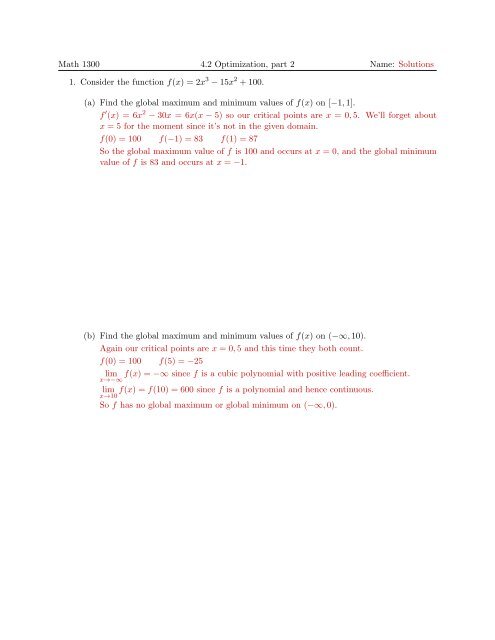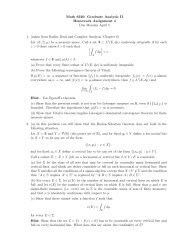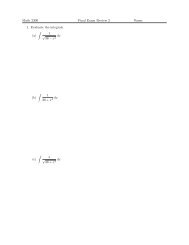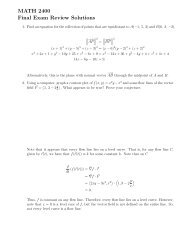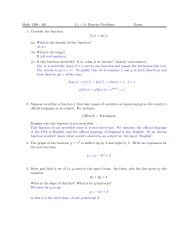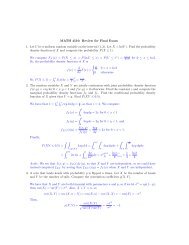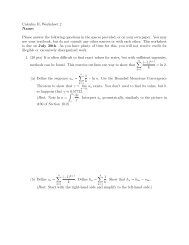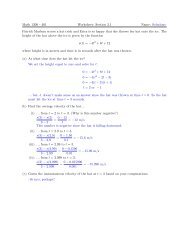Math 1300 4.2 Optimization, part 2 Name: Solutions 1. Consider the ...
Math 1300 4.2 Optimization, part 2 Name: Solutions 1. Consider the ...
Math 1300 4.2 Optimization, part 2 Name: Solutions 1. Consider the ...
Create successful ePaper yourself
Turn your PDF publications into a flip-book with our unique Google optimized e-Paper software.
<strong>Math</strong> <strong>1300</strong> <strong>4.2</strong> <strong>Optimization</strong>, <strong>part</strong> 2 <strong>Name</strong>: <strong>Solutions</strong><strong>1.</strong> <strong>Consider</strong> <strong>the</strong> function f(x) = 2x 3 − 15x 2 + 100.(a) Find <strong>the</strong> global maximum and minimum values of f(x) on [−1, 1].f ′ (x) = 6x 2 − 30x = 6x(x − 5) so our critical points are x = 0, 5. We’ll forget aboutx = 5 for <strong>the</strong> moment since it’s not in <strong>the</strong> given domain.f(0) = 100 f(−1) = 83 f(1) = 87So <strong>the</strong> global maximum value of f is 100 and occurs at x = 0, and <strong>the</strong> global minimumvalue of f is 83 and occurs at x = −<strong>1.</strong>(b) Find <strong>the</strong> global maximum and minimum values of f(x) on (−∞, 10).Again our critical points are x = 0, 5 and this time <strong>the</strong>y both count.f(0) = 100 f(5) = −25lim f(x) = −∞ since f is a cubic polynomial with positive leading coefficient.x→−∞f(x) = f(10) = 600 since f is a polynomial and hence continuous.limx→10So f has no global maximum or global minimum on (−∞, 0).
<strong>Math</strong> <strong>1300</strong> <strong>4.2</strong> <strong>Optimization</strong>, <strong>part</strong> 2 <strong>Name</strong>: <strong>Solutions</strong>2. <strong>Consider</strong> <strong>the</strong> function f(x) = 2x 3 − 6x 2 − 144x.(a) Find <strong>the</strong> global maximum and minimum values of f(x) on [−6, 6].f ′ (x) = 6x 2 − 12x − 144 = 6(x 2 − 2x − 24) = 6(x − 6)(x + 4) so our critical pointsare x = −4, 6.f(−4) = 352 f(6) = −648 f(−6) = 216So <strong>the</strong> global max is 352 and occurs at x = −4 and <strong>the</strong> global min is −648 and occursat x = 6.(b) Find <strong>the</strong> global maximum and minimum values of f(x) on (−5, 5).From our critical points −4 and 6 we now only care about −4.f(−4) = 352lim f(x) = f(−5) = 320x→−5f(x) = f(5) = −620limx→5So f has no global maximum or global minimum on (−5, 5).
<strong>Math</strong> <strong>1300</strong> <strong>4.2</strong> <strong>Optimization</strong>, <strong>part</strong> 2 <strong>Name</strong>: <strong>Solutions</strong>3. <strong>Consider</strong> <strong>the</strong> function f(x) = 5 ln(x) − x.(a) Find <strong>the</strong> global maximum and minimum values of f(x) on [3, 10].f ′ (x) = 5 x − 10 = 5 − 1 ⇒ x = 5 is our critical point.xf(5) = 5 ln(5)−5 ≈ 3.047 f(3) = 5 ln(3)−3 ≈ 2.493 f(10) = 5 ln(10)−10 ≈ <strong>1.</strong>513So <strong>the</strong> global max is 5 ln(5) − 5 and occurs at x = 5, and <strong>the</strong> global min is 5 ln(10) − 10and occurs at x = 10.(b) Find <strong>the</strong> global maximum and minimum values of f(x) on (0, ∞).As before, our only critical point is at x = 5, and f(5) = 5 ln(5) − 5 ≈ 3.047.limx→0x→0f(x) = lim (5 ln(x) − x) = −∞+ +lim f(x) = lim (5 ln(x) − x) = −∞ (by looking at <strong>the</strong> graph)x→∞ x→∞So f has a global max value of 5 ln(5) − 5 at x = 5, but no global minimum.
<strong>Math</strong> <strong>1300</strong> <strong>4.2</strong> <strong>Optimization</strong>, <strong>part</strong> 2 <strong>Name</strong>: <strong>Solutions</strong>4. <strong>Consider</strong> <strong>the</strong> function f(x) = xe −x .(a) Find <strong>the</strong> global maximum and minimum values of f(x) on [0, 2].f ′ (x) = e −x − xe −x = (1 − x)e −x so our only critical point is at x = <strong>1.</strong>f(1) = 1e −1 = 1/e ≈ 0.368 f(0) = 0e −0 = 0 · 1 = 0 f(2) = 2e −2 = 2 e 2 ≈ 0.271So f has a global max value of 1/e at x = 1 and a global min value of 0 at x = 0.(b) Find <strong>the</strong> global maximum and minimum values of f(x) on (0, ∞).Again our critical point is just at x = 1 and f(1) = 1e −1 = 1/e ≈ 0.368.lim f(x) = f(0) = 0x→0xlim f(x) = lim = 0 since exponential growth dominates linear growth.x→∞ x→∞ ex So f has a global max value of 1/e at x = 1 but no global min.


